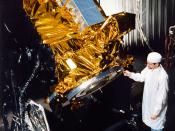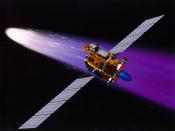Sebastian Selena
Ms. Goodwin
English 10H Period 5
10 March 2014
Inability to Explore Deep Space
Man has gone through multiple advancements in technology between the 19th century and the current 21st century. Many of which were big leaps for Mankind; Neil Armstrong proposed, "That's one small step for a man, one giant leap for mankind." Since then, NASA's budget has decreased exponentially, due to the loss of government support. Today, Space agencies don't have the necessary requirements to explore deep space. There is an insufficient amount of knowledge to create the technology in order to travel where no man has ever gone before. NASA, SpaceX, the European Space Agency (ESA), and many more organizations are working hard to develop blueprints for new sophisticated technology. The problem with this is that they don't have enough funds to pull resources together to build a spacecraft and to test on many more. Even with these resources there are a huge number of Environmental factors hindering the human race from exploring deep space. (Scullion).The solutions can be from multiple ranges. From advanced ion engines to warp drives to spiritual realms of the human consciousness.
One of many environmental factors is Radiation, which comes from cosmic rays, solar wind and solar energy particles emitted during a solar storm. Particles from these sources soar through space and can go right through a human body. So, the radiation hazards astronaut's face is serious. Mass and weight are important because the bigger the spacecraft the heavier it's going to be, and the heavier it's going to be, the more power will be needed to escape the earth's gravitational pull. A Spacesuit is obviously the most important factor for an astronaut traveling through outer space. It gives the astronaut air for 6-8 hours, and also maintains the astronauts normal temperature using layers of insulation and a cooling system.( Scullion)
Space debris, meteoroids and micrometeorites are always a problem with space travel. Space debris can be anything, from tiny flecks of paint, a metal bolt or even an inoperative satellite. Over a million pieces and chunks of space debris speed through space at around 4 miles per second, but so do meteoroids and micrometeorites. Meteoroids are pieces of rock and metal floating through space which are often left over pieces of rock from the formation of the Solar System. Micrometeorites are even smaller pieces of meteoroids, and can do just as much damage to a suit as a piece of space debris. ( Scullion) Communication, another environmental factor, is very important because this is how the astronauts and space probes will stay in contact with earth. If the communication line is down how will NASA know if the astronauts are safe/ If they should send a one manned space probe out to see what has happened or if there's a way to fix the line? Well, NASA is already trying to figure it out. They believe that planting satellites that can shoot laser beams containing data to send to each satellite (microwaves) across the solar system should fix the problem. ( Science and Technology) However, one problem still remains, they need to know what the fastest way to plant a satellite is, because it takes a lot of patience to find when the timing is perfect to send a satellite into (for example) Jupiter's orbit. If it goes to fast Jupiter's gravity won't have an effect and it'll "fly" right past it. If it goes too slow it'll be pulled in and crushed from the Jupiter's atmospheric pressure.
To explore deep space, NASA needs to figure out methods of advanced propulsion. The construction of advanced propulsion systems would require a vast amount of resources. However, they need to know what these engines will need to propel the spacecraft. So, knowledge of new technologies are needed to choose what resources NASA needs, to build such sophisticated engines. They also have to know how to pull resources together; where to find them, and if they're on another planet. Here are a few examples: To build warp drives they need to learn more about a new kind of physics. Right now scientists are currently trying to discover this new physics. A warp drive is the only technology that crosses the unreachable barrier of light speed. If Fusion and deep space propulsion systems are to be understood space organizations will need the knowledge, resources and technology to go far into the research. ( Engines for the Cosmos)
An (ECR) or Electron resonance chamber is another way to fly quickly through space, although designing an electron cyclotron resonance chamber (ECR), will take a while. An ECR chamber heats electrons in the propellant atoms, which creates plasma, and is then used to propel the spacecraft. To design it, they'll need to do a number of experiments; this will help improve performance on their ion thrusters. Another cause for not being able to explore deep space is that building a scalar field (used to make shortcuts throughout space; similar to a warp drive) is a (very hard challenge), NASA has to understand the new physics that is occurring in this process. ( Ion Propulsion)
To explore deep space, every space organization must come to realize that they need to build more space probes that will go further into the reaches of the universe to understand this new physics. So, many solutions require the understanding of a new physics that not even Stephen Hawking can explain it. On the other hand, there are multiple ways to avoid this, (there are many solutions that do not require research on the new physics) such as: An ion Propulsion engine, which is long lasting, up to 5 and a half years. It uses the solar electric propulsion which increases the speeds of the spacecraft, with the use of a Xenon propellant. The max speed is 90,000 miles per hour. ( NASA Thruster Achieves)
Ion thrusters are another way, it's much faster than chemical rockets and uses electromagnetic effects to generate propulsive force. Ion thrusters are 50 times more effective than our traditional chemical rockets. (Engines for the Cosmos) Before getting into Rocket propulsion the reader must understand what the rules are for escaping earth's atmosphere. To get out of earth's atmosphere one will need high thrust, on the other hand, to get into deep space one will need either a higher specific impulse or a high exhaust velocity. A high specific impulse means that one is converting fuel energy (instead of the fuel) into momentum. ( To Go Beyond.) Now that you know the rules, Rocket Propulsion uses higher specific impulse. Rocket Propulsion uses the energy from fusion or fission to propel the ship. (Engines for the Cosmos)
Now, the Hall Effect in Space was created by the Russians and uses a different method. Specifically, shooting charged xenon gas particles. They have an electric field, but with magnets circling the engine chamber, with a rod going down the middle of it. (This increases the velocity of the gas particles.) This method is not as efficient as NASA's Ion engines, but still works. ( Deep-space Engines)
The last solution is the Solar Sail. It is propelled by the constant pressure of photons from the sun. When the photons hit the sail, enough pressure would propel it through the solar system. Once it is out of Earth's atmosphere, it will travel forever. ( Deep-space Engines)
Hopefully the scientists at the forefront of the space exploration have thought of everything that a lay person... could speculate. Because the research being done at other space organizations are so complex a lay person might choose some possible outlandish solutions. Thusly, a lay person's solution will be more toward the nontraditional nature and not of the above stated solutions. One of the solutions is to talk with aliens. Yes, it is very likely that we may come across aliens. In fact, on voyager 1, NASA put coded information on the human's race DNA structure and in general what lives on Planet Earth. As a result (or supposedly) Earth got a message back by crop circles crop (circles are a pattern that can be seen from above and are made from barley, wheat, rye, or maize. The crop formation is usually created overnight) describing very similar characteristics of their DNA structure. Although this could very well be a hoax, there is very little evidence suggesting it. Talking or communicating with aliens, if they're friendly enough, may actually either educate us or give us the technology we need to explore deep space. The drake equation supports this theory. In general it estimates the number of technological civilizations that might exist among the stars; the probability is likely. Channeling spirits through Ouija boards or through direct communication might work. Through a Ouija board one might actually be given the answers needed to explore deep space. With astral projections, one is partially independent with an expansion of the consciousness as a result. This method has no speed limit. There is no proof that light speed cannot be passed. The reason is that scientists have said the same thing in passing the speed of sound. What happened? Well, let's just say that the challenge was overcome with a simple jet. So the reality is, that any of these three solutions might actually work, just like one of the Space organizations solutions might work someday. To be able to do all of these methods of solutions the government needs to see NASA as an important factor in making "small steps for man and giant leaps for mankind."
Works Cited
"Beginner's Guide to Propulsion." Beginner's Guide to Propulsion . National Aeronautics and Space Administration, n.d. Web. 10 Mar. 2014. <http://www.grc.nasa.gov/WWW/K-12/airplane/bgp.html>.
COFFEY, JERRY. "How Long Does It Take to Get to Jupiter?" Universe Today RSS . Universe Today, 16 June 2008. Web. 08 Mar. 2014. <http://www.universetoday.com/15092/how-long-does-it-take-to-get-to-jupiter/>.
"Deep-space Engines." Popular Science Apr. 2013: 1-2. Science in Context . Web. 19 Feb. 2014.
Dunbar, Brian. "Ion Propulsion." NASA . NASA, 21 May 2008. Web. 10 Mar. 2014. <http://www.nasa.gov/centers/glenn/about/fs21grc_prt.htm>.
"Engines for the Cosmos: Exploration of Deep Space Requires Systems of Propulsion That Can Go the Distance." Mechanical Engineering-CIME (2003): 1-5. Science in Context . Web. 19 Feb. 2014.
"Exotic Material as Interactions between Scalar Fields." Progress in Physics (2006): 1-11. Science in Context . Web. 19 Feb. 2014.
Gabriels, Paul. "NASA Instrument Determines Hazards of Deep-Space Radiation." NASA . NASA, 18 Nov. 2013. Web. 10 Mar. 2014. <http://www.nasa.gov/content/goddard/nasa-instrument-determines-hazards-of- deep-space-radiation/#.Ux1DFz9dWuJ>.
Marshall, William M. "Breakthrough Propulsion Physics." Breakthrough Propulsion Physics . National Aeronautics and Space Administration, 19 Nov. 2008. Web. 10 Mar. 2014. <http://www.grc.nasa.gov/WWW/bpp/>.
"-NASA Thruster Achieves World-Record 5+ Years of Operation." Science in Context . Gale, 26 June 2016. Web. 19 Feb. 2014.
"NASA's Work on Advanced Spacecraft Propulsion Systems." Science in Context . Gale, 2010. Web. 19 Feb. 2014.
"Remote Agent." Why Don't We Just Send Astronauts on Deep Space Trips? N.p., n.d. Web. 10 Mar. 2014. <http://www.qrg.northwestern.edu/projects/vss/docs/Remote-agent/2-why-not-astronauts.html>.
Scullion, Kerry. "The Dangers of Space Travel." Astronotes . Astronotes, 8 June 2013. Web. 10 Mar. 2014. <http://www.armaghplanet.com/blog/the-dangers-of-space-travel.html>.
"To Go Beyond: Experiments with an Advanced Electromagnetic Engine Aim for High-speed, Long-distance Transportation to Reach Farther into Space." Mechanical Engineering-CIME (2008): 1-5. Science in Context . Web. 19 Feb. 2014.
Townes, Steve, Joseph Yuen, and Leslie Deutsch. "Science and Technology: Research Topics Details." Science and Technology: Research Topics Details . Jet Propulsion Laboratory, n.d. Web. 10 Mar. 2014. <http://scienceandtechnology.jpl.nasa.gov/research/ResearchTopics/topicdetails/? ID=67>.
Selena


